Abstract
Dry reforming of methane is an advantageous technique to produce syngas by using greenhouse gases like CO2 and CH4. This study investigated the stability, catalytic effectiveness, and physicochemical characteristics of mono- and trimetallic catalysts based on Ni and supported on γ-Al2O3. Adding Co and Fe has been found to modify the structure and surface through the characterizations, including XRD, SEM, TEM, BET, H2-TPR, and XPS methods. Compared to the monometallic Ni catalyst, the trimetallic catalysts exhibited improved alloy formation, reduced particle size, increased metal dispersion, and enhanced surface area and pore structures. The 10% Ni, 2.5% Co, and 2.5% Fe-Al2O3 catalyst exhibits higher CH4 conversion, surpassing 75%, and also CO2 conversion around 85% at 700 °C, compared to 15% Ni-Al2O3, which showed CH4 conversion of about 65% and CO2 conversion of 70%. It also showed comparatively good stability in 24 h testing performed at 700 °C. According to the findings of the research on trimetallic catalysts, their capacity to improve dry reforming of methane (DRM) performance may be attributed to increased stability, which is a crucial challenge in the production of sustainable syngas, as well as higher activity and lower deactivation.
1. Introduction
The use of fossil fuels has dramatically grown in recent years owing to increased population and industrial demands, which cause various pollutants to enter the atmosphere. As a result, carbon dioxide emissions and other greenhouse gases, the primary contributors to climate change and global warming, have risen sharply. Another greenhouse gas is methane, which is 25 times more potent in contributing to global warming [1,2,3,4]. However, fossil fuels will be unable to meet the world’s growing energy needs in the future due to their limitations as non-renewable resources. Therefore, utilizing renewable energy sources to lower greenhouse gas emissions is crucial. Over 100 countries have set goals and strategies for renewable energy since 2012 [5]. Some technical ways, such as capture, catalytic transformation, and sequestration, have been utilized to decrease emissions of the two primary GHGs (CH4 and CO2). Using synthesis gas is a more sustainable fuel substitute that mostly consists of H2 and CO. The Fischer–Tropsch (FT) procedure is the basis of the gas-to-liquid (GTL) process, which makes syngas (CO + H2) a flexible intermediary that allows natural gas to be converted into synthetic hydrocarbon fuels and specialty lubricants [6]. In the first two decades of the twenty-first century, there was an increased interest in this reaction owing to the global effort to reduce greenhouse gas output and atmospheric emissions. Changing the composition of automotive fuels is one way to achieve this goal [7]. The most essential link between different carbon resources and fuels/chemicals is syngas. Numerous products, including oxygenates and hydrocarbons (methanol, ethanol, or other C2 oxygenates), that can be used as liquid fuels or building-block chemicals may be generated from synthetic gas [8,9,10].
Syngas can be generated by different reforming techniques, one of the most promising being natural gas reforming, also known as methane reforming. It can be conducted catalytically using either an exothermic or an endothermic process, depending on the chemical reactions utilized. Several reforming processes, including steam reforming of methane (SRM), dry reforming of methane (DRM), partial oxidation of methane (POM), auto-thermal reforming (ATR), and combined reforming of methane (CRM), can be used to produce syngas from methane, the primary component of natural gas [11]. These reactions are demonstrated in Table 1.

Table 1.
Syngas formation with different reforming processes.
Dry reforming of methane (DRM) is an endothermic catalytic reforming process that utilizes carbon dioxide and methane as feedstocks to generate syngas. The produced syngas has an H2/CO ratio close to 1, making it particularly suitable for downstream applications such as Fischer–Tropsch synthesis [12,13,14,15]. Among the different methane reforming methods, DRM stands out as the most effective for biogas utilization. Unlike other processes, it eliminates the need for CO2 separation, incorporates both carbon atoms from the feed into the final product, minimizes waste, and improves overall yield [16]. Environmentally, DRM offers substantial benefits: it decreases greenhouse gas emissions by converting biogas into valuable syngas, and it enables the use of natural gas streams with high CO2 content [17,18,19]. DRM may also represent the only economically feasible method to utilize landfill gas, which often contains low concentrations of methane and is typically flared or vented—actions that contribute to environmental and public health risks [20]. Furthermore, DRM holds promise for thermochemical energy applications, such as heat-pipe systems for storing, transporting, and recovering solar or renewable energy. This is made possible by the high heat demand of the reaction and the potential reversibility of the system [21].
However, the DRM reaction is kinetically slow and highly energy intensive. Significant thermal input is needed to overcome the strong molecular bonds of CO2 (526 kJ/mol) and CH4 (435 kJ/mol), enabling the formation of syngas at equilibrium. Additionally, side reactions like the reverse water-gas shift (RWGS) can occur, which further changes the equilibrium. RWGS reduces the H2/CO ratio to below 1 by converting CO2 into CO and H2O, impacting the syngas composition (Equation (1)).
Furthermore, there are two competing reactions, including the CH4 decomposition reaction (Equation (2)) and Boudouard (Equation (3)), which result in carbon formation by blocking the metal active sites and catalyst deactivation [22].
Carbon gasification is another pathway that can happen parallel to the DRM reaction (Equation (4)) [23].
The primary reaction of the DRM is significantly endothermic and is similarly promoted by low pressure, although it demands elevated temperatures. The standard free energy change was used to determine the minimum operating temperatures for CH4 decomposition, CO2 reforming, and the upper limiting temperatures of the RWGS and Boudouard process. Above 640 °C, the CH4 + CO2 reaction and the methane cracking reaction can proceed; however, more than 820 °C, RWGS and the Boudouard reactions are hindered. Methane cracking, or the Boudouard process, will generate carbon at 557–700 °C [24]. The catalysts used under DRM reaction conditions may become less effective owing to the sintering of active metals and deactivation caused by the high reaction temperatures required for the process. Ni-based catalysts have attracted significant interest in the dry reforming of methane due to their cost-effectiveness, availability, and primary activity comparable to noble metal catalysts. A significant challenge is the rapid sintering and deactivation of Ni brought on by carbon production [25,26,27]. One of the most common approaches to minimize catalyst coking is using an appropriate support that possesses surface/subsurface oxygen mobility with adequate CO2 activation capability [28]. Oxide supports like alumina, which possess an elevated specific surface area and excellent thermal resistance, are essential owing to the high-temperature demands of DRM. The intense connection between the metal and support means that utilizing Ni supported by Al2O3 can decrease carbon buildup and enhance catalyst stability [29]. Another popular approach in catalyst design is adding another metal to the catalyst as a promoter. Alkali and alkaline metals from the earth, like potassium, are the most often used promoters because they can improve catalytic efficiency in a variety of ways and strengthen resistance to carbon deposition. Promoters limit coke from building up on larger Ni particles or step-edge sites on the surface of Ni by blocking extremely reactive sites [30,31,32]. An alternative approach includes the utilization of bimetallic catalysts and has been attracting research attention recently. The improved activity, selectivity, and stability properties of bimetallic catalysts can be attributed to their distinctive chemical and physical properties that differentiate them from their base metals. The research indicates that the Ni-Fe alloy can inhibit carbon formation and improve the metal–support interaction, leading to better dispersion because of the redox properties contributed by Fe [33,34]. Also, Co and Ni have similar radii, which facilitates the formation of an alloy within a specific molar range, which leads to faster activation of CH4. On the other hand, Co’s high oxygen affinity can significantly boost the amount of O on the catalyst surface and improve carbon gasification [35]. Joo et al. employed topotactic exsolution in the PBMCoNi system to produce Co-Ni-Fe ternary alloy nanoparticles. Consequently, the d-band center of the Co-Ni-Fe ternary alloy was elevated, promoting the activation of the CO2 and CH4 reactants [36].
In this research, the synergetic effect of transition metals due to alloy formation was investigated in the DRM. For this purpose, Ni, Co, and Fe supported on γ-Al2O3 catalysts with different ratios of metals were synthesized, and their catalytic performance in the DRM was compared to the reference Ni-Al2O3 catalyst.
2. Results and Discussion
2.1. Characterization of Catalysts Before DRM Reaction
2.1.1. Fresh Samples
The textural property analysis results are displayed in Figure 1 and Table 2. All isotherms showed type IV hysteresis, a sign that mesopores are present. The pure alumina support has a BET surface area of 102 m2/g. Adding metal to γ-Al2O3 decreased the surface area while increasing pore volume and pore size. Among all samples, 15 Ni-Al2O3 revealed the lowest surface area. The results show that adding moderate amounts of mixed metals maintains a higher surface area while offering increased pore volume and size. Promoted Ni-Al2O3 catalysts with other metals could optimize catalyst performance by providing sufficient surface area for adsorption while ensuring accessible pore structures for reactant diffusion [37,38].
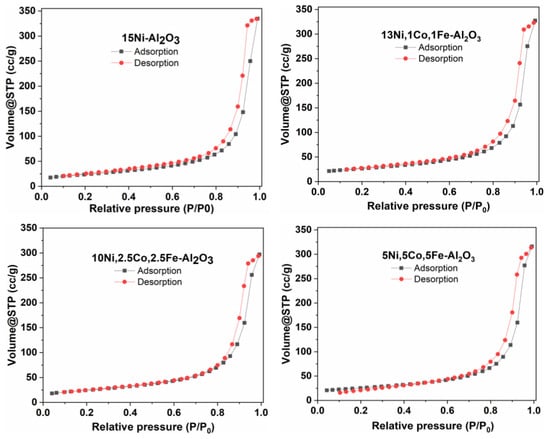
Figure 1.
N2 adsorption–desorption isotherms of the reference Ni-Al2O3 and trimetallic catalysts.

Table 2.
N2 adsorption–desorption analysis results.
The SEM imaging analysis was conducted to investigate the morphology and dispersion of the catalyst particles (Figure 2). The Ni-Al2O3 sample shows large, dense agglomerates, indicating partial aggregation of Ni particles and non-uniform particle distribution (Figure 2a,b). In contrast, the trimetallic catalyst exhibits a more finely textured and homogeneously distributed surface with smaller and more uniformly dispersed particles (Figure 2c,d). These characteristics are likely to contribute to superior catalytic performance, offering a greater number of active sites, higher resistance to sintering, and improved thermal stability during high-temperature dry reforming of methane (DRM). In comparison, the Ni-Al2O3 catalyst may be more prone to deactivation due to sintering or coke formation, given its less uniform structure and lower dispersion.
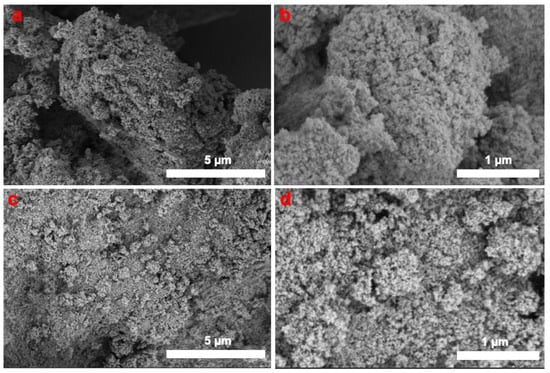
Figure 2.
Scanning electron microscopic images of of (a,b) 15Ni-Al2O3; (c,d) 10Ni, 2.5Co, 2.5Fe-Al2O3.
2.1.2. Reduced Samples
Before the DRM, the catalysts were subjected to high-temperature reduction (at 650 °C for 1 h), which induced significant changes in their active phases and structures. Therefore, the bulk and surface states of the catalysts after the reduction were also studied.
Figure 3 shows the TEM images and particle size distribution in 15Ni-Al2O3 and 10Ni, 2.5Co, 2.5Fe-Al2O3. Based on TEM images, a variation in particle morphology was seen, owing to the addition of Co and Fe and alloy formation. These metals affect the crystallinity and dispersion of the particles. Trimetallic catalysts showed better homogeneity than monometallic. Utilization of Co and Fe helps to decrease the agglomeration effect of Ni and leads to better metal dispersion on the support surface. Trimetallic catalysts have around 3 nm smaller particle size than 15Ni-Al2O3. The reduced particle size results in an increased surface area, influencing the activity and stability of catalysts by offering more active sites and enhancing reaction rates [39,40].
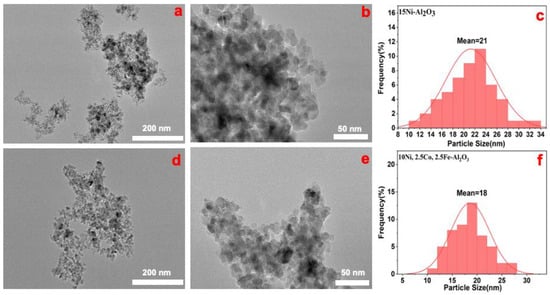
Figure 3.
(a–c) TEM images and Ni particle size distribution of reduced 15Ni-Al2O3, and (d–f) TEM and Ni particle size distribution of reduced 10Ni, 2.5Co, 2.5Fe-Al2O3 catalyst.
The XRD patterns of the reduced catalysts for monometallic and trimetallic catalysts are shown in Figure 4a. All samples displayed typical reflections of the γ-Al2O3 crystalline phase with peaks detected at 2θ angles of 31.9°, 37.1°, 39.2°, 45.5°, 67.0°, and 76.3° and assigned to the (220), (311), (222), (400), (511), and (440) planes of γ-Al2O3, respectively (JCPDS PDF# 10-0425). The diffraction peaks corresponding to metallic nickel (Ni) were observed at 44.2°, 51.9°, 76.3°, and 92.7° (2θ), which are assigned to the (111), (200), (220), and (311) planes of face-centered cubic (FCC) Ni, respectively. Among them, the peaks at 51.9° and 76.3°—attributable to the (200) and (220) planes—were the most intense in all catalysts. The XRD patterns of trimetallic catalysts showed slight shifts compared with 15Ni-Al2O3, indicating the incorporation of Co and Fe in the Ni lattice (Figure 4b). This shift led to changes in lattice parameters due to alloy formation, which can positively influence the catalytic activity and stability during the DRM by resisting sintering and carbon deposition. It also improves the dispersion of the active sites and stabilizes the catalysts in the reaction conditions [41,42,43,44].
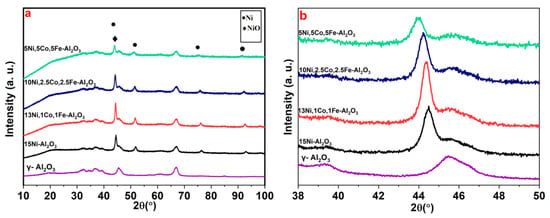
Figure 4.
(a) XRD pattern of reduced catalysts; (b) Partially enlarged XRD graphs of the reduced samples.
Figure 5 illustrates the H2-TPR graph of the 15Ni-Al2O3, and 10Ni, 2.5Co, 2.5Fe-Al2O3 catalysts. A sharp and intense reduction peak is observed around 570 °C. This is characteristic of NiO species with strong interaction with the alumina support, likely forming NiAl2O4 spinel-like structures, which are difficult to reduce. In all trimetallic catalysts, the main reduction peak shifts toward lower temperatures, with the greatest change observed in 10Ni, 2.5Co, 2.5Fe-Al2O3 ~450 °C with a wider profile, which suggests a heterogeneous distribution of metal oxides and improved reducibility. This improvement can be attributed to the incorporation of Co and Fe into the Ni-Al2O3 catalyst, which significantly enhances the reducibility and dispersion of the active metal species. The downward shift in reduction temperature and broadening of the TPR profile suggest synergistic metal–metal interactions and improved catalyst activation, which are beneficial for the dry reforming of methane process [45].
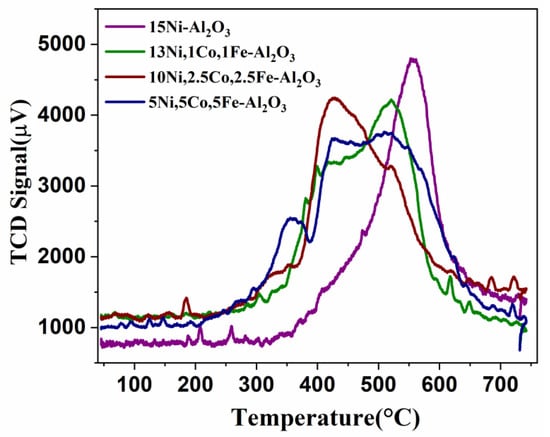
Figure 5.
H2-TPR profiles of the 15Ni-Al2O3 and 10Ni, 2.5Co, 2.5Fe-Al2O3.
The species’ elemental surface states were analyzed by X-ray Photoelectron Spectroscopy (XPS), and the results are presented in Figure 6. The high-resolution spectra were corrected using a Shirley background, and the peaks were fitted with a Gauss-Lorentzian product function, with the Lorentzian contribution set to 0.3. Surveys were conducted for two samples: 15Ni-Al2O3 and 10Ni, 2.5Co, 2.5Fe-Al2O3, as shown in Figure 6. The detected carbon was identified as adventitious C 1s, and the oxygen signal was attributed to the Al2O3 support material’s lattice. The Ni 2p 3/2 peak was located at 856.2 eV for both samples. This binding energy (along with the satellite structure) is characteristic of NiAl2O4 and NiO-Al2O3, which indicates a strong metal–support interaction (Figure 6a,b). A significant difference in binding energy was observed in the Al 2p 3/2 peak: 74.2 eV for the 15Ni-Al2O3 sample (Figure 6c) and 74.5 eV for the 10Ni, 2.5Co, 2.5Fe-Al2O3 sample (Figure 6d). These shifts might be due to structures like Co and Fe alloys. In the Fe 2p spectra of the 10Ni, 2.5Co, 2.5Fe-Al2O3 catalyst, the main peak corresponding to Fe 2p3/2 was observed around 710 eV, along with the satellite peak was at 713.3 (Figure 6e). These spectra correspond to Fe2+ and Fe3+, respectively. This suggests that Fe was not completely reduced. However, the XPS results did not show any significant presence of Co, possibly due to spectral overlaps [43,46,47].
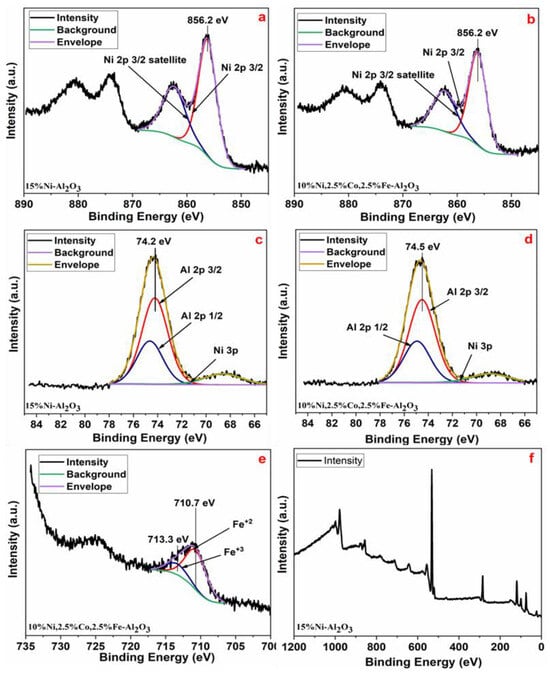
Figure 6.
Ni 2p XPS region for (a) Ni 2p XPS region for 15Ni-Al2O3; (b) Ni 2p XPS region for 10Ni, 2.5 Co, 2.5Fe-Al2O3; (c) Al 2p XPS region for 15Ni-Al2O3; (d) Al 2p XPS region for 10Ni, 2.5Co, 2.5Fe-Al2O3; (e) Fe 2p XPS region for 10Ni, 2.5Co, 2.5Fe-Al2O3; (f) XPS survey for 15Ni-Al2O3.
2.2. Catalytic Performance
To evaluate the influence of metal alloys on the DRM reaction and analyze the effectiveness of trimetallic catalysts, experiments were conducted at temperatures of 600, 650, and 700 °C for 24 h at atmospheric pressure. As illustrated in Figure 7a,b, 10Ni, 2.5Co, 2.5Fe-Al2O3 exhibited the highest CH4 conversion at all temperatures, which remained over 75% at 700 °C during 24 h. The sample containing 5Ni, 5Co, 5Fe on A2O3 also demonstrated stability, though at a lower conversion level of around 70%. Additionally, the conversion rates of 15Ni-Al2O3 and 13Ni, 1Co, 1Fe-Al2O3 were slightly lower, approximately 68%. Among all samples, the monometallic 15Ni-Al2O3 catalyst showed the lowest CH4 conversion over time. The CO2 conversion trends followed a similar pattern to those of CH4. As shown in Figure 7c,d, the trimetallic catalysts (10Ni, 2.5Co, 2.5Fe-Al2O3 and 5Ni, 5Co, 5Fe-Al2O3) achieved over 80% CO2 Conversion at 700 °C. In the isotherm phase, the 10Ni, 2.5Co, 2.5Fe-Al2O3 catalyst demonstrated the highest conversion, reaching approximately 85%. Among all tested catalysts, the monometallic 15Ni-Al2O3 exhibited the lowest performance with the greatest fluctuations throughout the reaction time. To ensure data reliability, all DRM tests were repeated three times. The resulting error bars are presented in the Supplementary Information (Figure S1a,b).
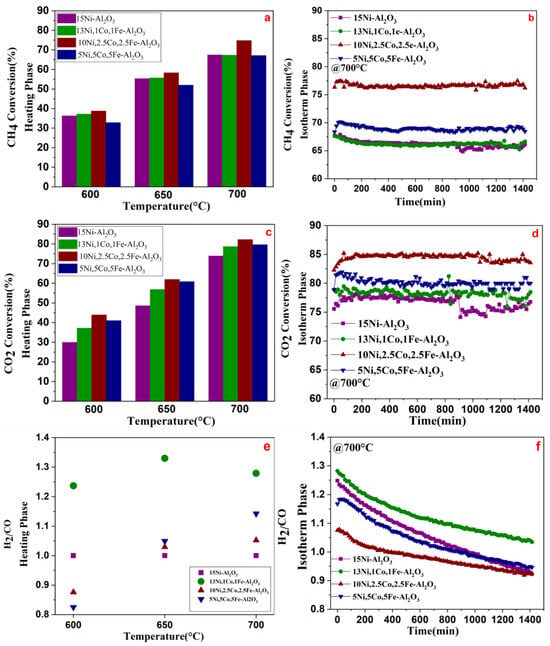
Figure 7.
Catalytic DRM performances of fresh 15Ni-Al2O3, 13Ni, 1Co, 1Fe-Al2O3, 10Ni, 2.5Co, 2.5Fe-Al2O3 and 5Ni, 5Co, 5Fe-Al2O3. (a) CH4 conversion at 600, 650, and 700 °C; (b) CH4 conversion at 700 °C for 24 h; (c) CO2 conversion at 600, 650, and 700 °C; (d) CO2 conversion at 700 °C for 24 h; (e) H2/CO ratio at 600, 650, and 700 °C; (f) H2/CO ratio for 24 h.
According to Figure 7e,f, the catalyst compositions significantly affect the H2/CO ratio. A higher Ni content catalyst typically produces a H2/CO ratio closer to 1. Adding Co and Fe influences the H2/CO ratio because of side reactions, including RWGS and carbon gasification. In addition, higher temperatures and longer reaction durations generally cause a higher ratio of H2/CO that may be related to the enhanced activity in reforming at higher temperatures and the gradual stabilization of the catalysts’ performance over time.
All catalysts demonstrated a gradual decrease in the ratio during the reaction. Among all of them, 10Ni, 2.5Co, 2.5Fe-Al2O3 maintained a more stable H2/CO profile. This stability is consistent with its proper hydrogen selectivity (Supplementary Information Figure S2a,b).
2.3. Characterizations of the Spent Catalysts
The Raman spectra, TG, XRD, and TEM techniques analyzed the carbon deposition and structure of the spent catalysts (Figure 8). In the spent samples’ Raman results, two vibration bands around 1350 and 1600 cm−1 are shown in Figure 8a,b, typically corresponding to the D and G bands linked to carbon content. In general, structural defects in carbonaceous materials are what initially lead to the D band, while in-plane carbon-carbon stretching vibrations cause the G band, which is a characteristic sign of graphitic phases. The intensity proportions of D/G bands for 15Ni-Al2O3 and 10Ni, 2.5Co, 2.5Fe-Al2O3 were 4 and 3.5, respectively, which, as a factor of the graphitization level assessment on the catalyst’s surface, can be concluded that the incorporation of additional metals enhances carbon resistance in the trimetallic catalyst. Figure 8c displays the TG curve of all catalysts after a long-term experiment. As can be observed, all spent catalysts showed rapid weight loss at temperatures higher than 500 °C, which was attributed to the oxidative breakdown of carbon contents on the used catalysts. Among all the catalysts, 13Ni, 1Co, 1Fe-Al2O3 showed the highest weight loss. This could be attributed to the fact that suboptimal amounts of Co and Fe not only fail to provide beneficial effects but may enhance carbon deposition, possibly due to unfavorable metal synergy. Furthermore, 15Ni-Al2O3 showed a slightly higher weight loss than the other trimetallic catalysts, suggesting that trimetallic catalysts have higher resistance to coke formation, likely due to better metal–support interactions [48,49]. The carbon balance calculations have also been provided in the Supplementary Information to support TG results and further clarification (Figure S3). The spent catalyst’s XRD is shown in Figure 8d. A peak is observed around 25–30° in all samples, which corresponds to carbon (C) deposition on the catalyst surface. As illustrated, the carbon peak in the 10Ni, 2.5Co, 2.5Fe-Al2O3 shows lower intensity among all catalysts, suggesting less carbon deposition.
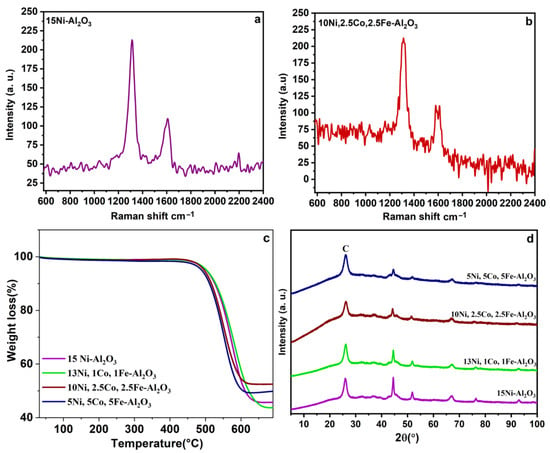
Figure 8.
(a,b) Raman spectra; (c) TG curves, and (d) XRD patterns of the spent catalysts.
The TEM image analysis of the post-reaction catalyst is displayed in Figure 9. The 10Ni, 2.5Co, 2.5Fe-Al2O3 alloy catalyst demonstrates better performance in DRM due to its reduced carbon filament formation, enhanced resistance to coking, and improved catalytic stability. The alloying effect changes carbon growth pathways, resulting in less structured carbon nanotube deposits and a more stable catalyst over time. This enhances its effectiveness for prolonged DRM operations compared to the 15Ni-Al2O3 catalyst, which showed significant carbon.
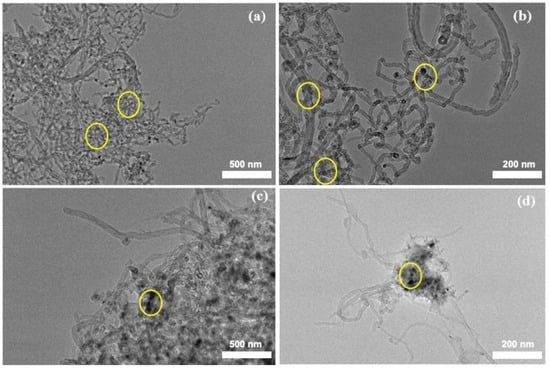
Figure 9.
TEM images of spent catalysts: (a,b) 15Ni-Al2O3; (c,d) 10Ni, 2.5Co, 2.5Fe-Al2O3.
The nanotube formation around the distinct black Ni particles and potential deactivation is a result of the coking [50,51,52].
3. Experimental
3.1. Catalyst Synthesis
Ni-Al2O3 Catalyst Synthesis:
The incipient wetness impregnation method was used to synthesize the Ni-Al2O3 catalyst. The precursor used was nickel (II) nitrate hexahydrate (Fisher Chemical). The impregnation solution was produced by dissolving a specific quantity of nickel (II) nitrate in deionized water. The γ-Al2O3 (Degussa AG) support was subsequently included in the impregnated solution under intense stirring to reach a homogeneous distribution of nickel species while drying. The prepared catalyst was dried in a vacuum oven for 12 h at 60 °C. This procedure was necessary for removing any moisture and getting the catalyst ready for calcination. Subsequently, the material was calcinated at 500 °C for 5 h, increasing the temperature by one degree each minute.
Preparation of Trimetallic Catalysts:
The trimetallic Ni, Co, Fe-Al2O3 catalysts were produced applying the same method, with the respective metal precursors: Nickel (II) nitrate hexahydrate, Cobalt (II) nitrate hexahydrate (Szkarabeusz), and Iron (III) nitrate nonahydrate (VWR Chemicals). Then the catalysts were calcined for 5 h at 500 °C, with a ramp rate of 1 °C·min−1. Ultimately, we developed three trimetallic catalysts, including the following:
13% Ni, 1% Co, 1% Fe-Al2O3: 13 wt% Ni, 1 wt% Co, 1 wt% Fe on Al2O3 support.
10% Ni, 2.5% Co, 2.5% Fe-Al2O3: 10 wt% Ni, 2.5 wt% Co, 2.5 wt% Fe on Al2O3 support.
5% Ni, 5% Co, 5% Fe-Al2O3: 5 wt% Ni, 5 wt% Co, 5 wt% Fe on Al2O3 support.
3.2. Catalyst Characterization
The physicochemical features of as-prepared catalysts, as well as before the DRM reaction, were characterized using various techniques. The specific surface area was evaluated using a Quantachrome NOVA 2200 gas sorption analyzer, N2 gas adsorption/desorption at −196 °C, and the BET and BJH equations. The samples were pretreated in a vacuum (<~0.1 mbar) at 200 °C for two hours before the measurements.
For surface structure analysis, a Thermo Fisher Scientific Apreo C scanning electron microscope (SEM) was utilized.
A Rigaku MiniFlex II Diffractometer with a Ni-filtered CuKα source was used for XRD measurements in the 2θ = 5–100°.
For surface structure analysis, a scanning electron microscope (SEM) from Thermo Fisher Scientific (Waltham, MA, USA), model Apreo C, was employed in high-vacuum mode with a secondary electron detector, utilizing an accelerating voltage of around 2 kV.
TEM images of the samples displayed on a carbon-coated copper grid were obtained using an FEI TECNAI G2 20 X-Twin high-resolution transmission electron microscope (fitted with electron diffraction) functioning at an accelerating voltage of 200 keV.
XPS measurements were performed in a Specs spectrometer using the XR50 dual anode X-ray source and Phoibos 150 hemispherical electron analyzer (Specs, Berlin, Germany). An X-ray source operated by Al Kα at 150 W and a power of 14 kV. Survey scans were recorded at a pass energy of 40 eV with a step size of 1 eV. All high-resolution scans were captured with a pass energy of 20 eV and an energy step of 0.1 eV. Charge referencing for all high-resolution spectra was carried out against the aliphatic element of the C1s peak at 284.8 eV. A Shirley background was employed for background correction in each instance.
Temperature-programmed reduction (TPR) was conducted in a BELCAT-A apparatus with a 9 mm outer diameter quartz tube heated from the outside. The catalysts were oxidized in oxygen at 200 °C for 30 min before the measurements. Then, the samples were cooled to room temperature in flowing N2. Following oxidation, the samples were purged with N2 including 10% H2 for 30 min and purged with N2 for 15 min, and the reactor was heated steadily at a rate of 10 °C min−1 from 50 °C to 800 °C. The consumption of H2/CO2 was measured by a thermal conductivity detector (TCD), and the flow rate was 50 mL min−1.
Raman spectra of all the samples were recorded by the Horiba Scientific LabRAM HR-800 laser Raman spectrometer. TG analysis was performed by TA Instruments TGA Q500, New Castle, DE, USA; 10 °C/min heating rate, 20–700 °C range, air atmosphere to identify the possible carbon deposition.
3.3. Catalytic Assessment
The pure Ni and trimetallic catalytic performance during the DRM reaction was conducted in a reactor with a fixed bed under atmospheric pressure. The load of catalyst particles was 0.1 g. Then, the catalyst reduction was performed by H2 flow (40 mL·min−1) at 650 °C for 1 h. After the reduction, a mixture of CH4 and CO2 with a molar ratio of 1:1 and a total flow rate of 60 mL·min−1 was introduced into the catalyst bed. The reactants and products, including H2, CO, CH4, and CO2, were separated with an HP-PLOT Q column and analyzed by gas chromatograph (Agilent 6890, Kromat Ltd. Budapest, Hungary). The conversion rates of CH4 and CO2, as well as the molar ratio of H2/CO, were calculated using the flow rates (F) of the corresponding gases at the inlet and outlet. To obtain consistent results from the GC inlet and outlet during DRM experiments, it is essential to maintain uniform reaction conditions, including temperature, pressure, and gas flow rate ratios. Therefore, it was allowed to run for 30 min to reach a steady state before taking measurements.
4. Conclusions
This study demonstrates that trimetallic Ni-Co-Fe catalysts have better performance than monometallic Ni catalysts in the DRM reaction. The development of Ni-Co-Fe alloys in trimetallic samples was confirmed through the physicochemical characterization analysis, which led to enhanced dispersion and lattice characteristics and improved catalytic activity and stability. Trimetallic catalysts were found to have more uniform dispersion and slightly smaller particle size in the SEM and TEM investigations, which increased the surface area and active sites available for the DRM reaction. According to the catalytic performance outcomes, the 10Ni, 2.5Co, 2.5Fe-Al2O3 catalyst demonstrated the highest CH4 and CO2 conversion rates, surpassing 75% and 85%, respectively, at 700 °C. Throughout a 24 h reaction, this catalyst also showed remarkable long-term stability with negligible deactivation. Owing to the lower amount of carbon deposition based on Raman, TG, and TEM post-reaction analysis, which highlighted the exceptional performance of the 10Ni, 2.5Co, 2.5Fe-Al2O3 catalyst. Alloying in trimetallic catalysts alters carbon growth pathways, resulting in fewer carbon deposits and a more stable catalyst for extended DRM operations. Overall, the results suggest that trimetallic catalysts have the potential to achieve sustained syngas generation by overcoming common DRM challenges, including carbon deposition and stability at high temperatures.
Supplementary Materials
The following supporting information can be downloaded at: https://www.mdpi.com/article/10.3390/catal15080797/s1, Figure S1: (a) Error bar for CH4 conversion, (b) Error bar for CO2 conversion. Figure S2: (a) H2 selectivity in heating phase, (b) H2 selectivity in Isotherm phase. Figure S3: Carbon balance.
Author Contributions
Conceptualization, methodology, and writing (original draft preparation); G.K.; review and editing, A.E. (Anastasiia Efremova) and H.S.B.; XPS and TEM measurements, I.S.; XPS measurements, Á.S.; coordination among authors, M.S.A.D.; supervision, A.E. (András Erdőhelyi), A.S., and Z.K.; funding acquisition, Á.K. and Z.K. All authors have read and agreed to the published version of the manuscript.
Funding
Tempus Public Foundation, FK 143583, and ZK, K_21 138714, from the source of the National Research, Development and Innovation, The Ministry of Human Capacities through the 20391-3/2018/FEKUSTRAT, TKP2021-NVA-19 under the TKP2021-NVA funding scheme of the Ministry for Innovation and Technology. Project no. RRF-2.3.1-21-2022-00009, titled National Laboratory for Renewable Energy, has been implemented with the support provided by the Recovery and Resilience Facility of the European Union within the framework of Programme Széchenyi Plan Plus.
Data Availability Statement
Data will be made available from authors upon reasonable request.
Conflicts of Interest
The authors declare no conflicts of interest.
References
- Owgi, A.H.K.; Jalil, A.A.; Hussain, I.; Hassan, N.S.; Hambali, H.U.; Siang, T.J.; Vo, D.V.N. Catalytic systems for enhanced carbon dioxide reforming of methane: A review. Environ. Chem. Lett. 2021, 19, 2157–2183. [Google Scholar] [CrossRef]
- Teh, L.P.; Setiabudi, H.D.; Timmiati, S.N.; Aziz, M.A.A.; Annuar, N.H.R.; Ruslan, N.N. Recent progress in ceria-based catalysts for the dry reforming of methane: A review. Chem. Eng. Sci. 2021, 242, 116606. [Google Scholar] [CrossRef]
- Sápi, A.; Rajkumar, T.; Ábel, M.; Efremova, A.; Grósz, A.; Gyuris, A.; Ábrahámné, K.B.; Szenti, I.; Kiss, J.; Varga, T.; et al. Noble-metal-free and Pt nanoparticles-loaded, mesoporous oxides as efficient catalysts for CO2 hydrogenation and dry reforming with methane. J. CO2 Util. 2019, 32, 106–118. [Google Scholar] [CrossRef]
- Khoshroo, G.; Sápi, A.; Szenti, I.; Efremova, A.; Bali, H.; ÁBrahámné, K.B.; Erdőhelyi, A.; Kukovecz, Á.; Kónya, Z. Pure Ni-Based and Trimetallic Ni-Co-Fe Catalysts for the Dry Reforming of Methane: Effect of K Promoter and the Calcination Temperature. Catal. Lett. 2022, 153, 2755–2762. [Google Scholar] [CrossRef]
- Gao, Y.; Jiang, J.; Meng, Y.; Yan, F.; Aihemaiti, A. A review of recent developments in hydrogen production via biogas dry reforming. Energy Convers. Manag. 2018, 171, 133–155. [Google Scholar] [CrossRef]
- Jeske, K.; Kizilkaya, A.C.; López-Luque, I.; Pfänder, N.; Bartsch, M.; Concepción, P.; Prieto, G. Design of Cobalt Fischer–Tropsch Catalysts for the Combined Production of Liquid Fuels and Olefin Chemicals from Hydrogen-Rich Syngas. ACS Catal. 2021, 11, 4784–4798. [Google Scholar] [CrossRef]
- Horáček, J. Fischer–Tropsch synthesis, the effect of promoters, catalyst support, and reaction conditions selection. Monatshefte Chem. 2020, 151, 649–675. [Google Scholar] [CrossRef]
- Cheng, K.; Kang, J.; King, D.L.; Subramanian, V.; Zhou, C.; Zhang, Q.; Wang, Y. Advances in Catalysis for Syngas Conversion to Hydrocarbons. In Advances in Catalysis; Academic Press Inc.: Cambridge, MA, USA, 2017; pp. 125–208. [Google Scholar]
- Yu, J.; Odriozola, J.A.; Reina, T.R. Dry Reforming of Ethanol and Glycerol: Mini-Review. Catalysts 2019, 9, 1015. [Google Scholar] [CrossRef]
- Chae, H.J.; Kim, J.-H.; Lee, S.C.; Kim, H.-S.; Bin Jo, S.; Ryu, J.-H.; Kim, T.Y.; Lee, C.H.; Kim, S.J.; Kang, S.-H.; et al. Catalytic technologies for CO hydrogenation for the production of light hydrocarbons and middle distillates. Catalysts 2020, 10, 99. [Google Scholar] [CrossRef]
- Ghoneim, S.A.; El-Salamony, R.A.; El-Temtamy, S.A. Review on Innovative Catalytic Reforming of Natural Gas to Syngas. World J. Eng. Technol. 2016, 4, 116–139. [Google Scholar] [CrossRef]
- Bu, K.; Deng, J.; Zhang, X.; Kuboon, S.; Yan, T.; Li, H.; Shi, L.; Zhang, D. Promotional effects of B-terminated defective edges of Ni/boron nitride catalysts for coking- and sintering-resistant dry reforming of methane. Appl. Catal. B Environ. 2020, 267, 118692. [Google Scholar] [CrossRef]
- Arora, S.; Prasad, R. An overview on dry reforming of methane: Strategies to reduce carbonaceous deactivation of catalysts. RSC Adv. 2016, 6, 108668–108688. [Google Scholar] [CrossRef]
- Gao, X.; Ge, Z.; Zhu, G.; Wang, Z.; Ashok, J.; Kawi, S. Anti-coking and anti-sintering Ni/Al2O3 catalysts in the dry reforming of methane: Recent progress and prospects. Catalysts 2021, 11, 1003. [Google Scholar] [CrossRef]
- Abasaeed, A.E.; Al-Fatesh, A.S.; Naeem, M.A.; Ibrahim, A.A.; Fakeeha, A.H. Catalytic performance of CeO2 and ZrO2 supported Co catalysts for hydrogen production via dry reforming of methane. Int. J. Hydrogen Energy 2015, 40, 6818–6826. [Google Scholar] [CrossRef]
- Bradford, M.C.J.; Vannice, M.A. CO2 reforming of CH4. Catal. Rev. Sci. Eng. 1999, 41, 1–42. [Google Scholar] [CrossRef]
- Kohn, M.P.; Castaldi, M.J.; Farrauto, R.J. Biogas reforming for syngas production: The effect of methyl chloride. Appl. Catal. B Environ. 2014, 144, 353–361. [Google Scholar] [CrossRef]
- Lucrédio, A.F.; Assaf, J.M.; Assaf, E.M. Reforming of a model biogas on Ni and Rh–Ni catalysts: Effect of adding La. Fuel Process. Technol. 2012, 102, 124–131. [Google Scholar] [CrossRef]
- Lunsford, J.H. Catalytic conversion of methane to more useful chemicals and fuels: A challenge for the 21st century. Catal. Today 2000, 63, 165–174. [Google Scholar] [CrossRef]
- Rasi, S.; Veijanen, A.; Rintala, J. Trace compounds of biogas from different biogas production plants. Energy 2007, 32, 1375–1380. [Google Scholar] [CrossRef]
- Verykios, X. Catalytic dry reforming of natural gas for the production of chemicals and hydrogen. Int. J. Hydrogen Energy 2003, 28, 1045–1063. [Google Scholar] [CrossRef]
- Hussien, A.G.S.; Polychronopoulou, K. A Review on the Different Aspects and Challenges of the Dry Reforming of Methane (DRM) Reaction. Nanomaterials 2022, 12, 3400. [Google Scholar] [CrossRef]
- Benedetti, V.; Ail, S.S.; Patuzzi, F.; Baratieri, M. Valorization of char from biomass gasification as catalyst support in dry reforming of methane. Front. Chem. 2019, 7, 119. [Google Scholar] [CrossRef]
- Sun, J.; Wang, S.; Guo, Y.; Li, M.; Zou, H.; Wang, Z.-J. Carbon dioxide reforming of methane over nanostructured Ni/Al2O3 catalysts. Catal. Commun. 2018, 104, 53–56. [Google Scholar] [CrossRef]
- Ali, S.; Khader, M.M.; Almarri, M.J.; Abdelmoneim, A.G. Ni-based nano-catalysts for the dry reforming of methane. Catal. Today 2019, in press. [CrossRef]
- Yan, X.; Hu, T.; Liu, P.; Li, S.; Zhao, B.; Zhang, Q.; Jiao, W.; Chen, S.; Wang, P.; Lu, J.; et al. Highly efficient and stable Ni/CeO2-SiO2 catalyst for dry reforming of methane: Effect of interfacial structure of Ni/CeO2 on SiO2. Appl. Catal. B Environ. 2019, 246, 221–231. [Google Scholar] [CrossRef]
- Ian, Z.; Das, S.; Ing, M.; Wai, H.; Hongmanorom, P.; Kawi, S. A Review on Bimetallic Nickel-Based Catalysts for CO2 Reforming of Methane. ChemPhysChem 2017, 18, 3117–3134. [Google Scholar] [CrossRef]
- Horváth, A.; Németh, M.; Beck, A.; Maróti, B.; Sáfrán, G.; Pantaleo, G.; Liotta, L.F.; Venezia, A.M.; La Parola, V. Strong impact of indium promoter on Ni/Al2O3 and Ni/CeO2-Al2O3 catalysts used in dry reforming of methane. Appl. Catal. A Gen. 2021, 621, 118174. [Google Scholar] [CrossRef]
- Xu, Y.; Du, X.H.; Li, J.; Wang, P.; Zhu, J.; Ge, F.J.; Zhou, J.; Song, M.; Zhu, W.Y. A Comparison of Al2O3 and SiO2 supported Ni-based Catalysts in their performance for the dry reforming of methane. J. Fuel Chem. Technol. 2019, 47, 199–208. [Google Scholar] [CrossRef]
- Tsiotsias, A.I.; Charisiou, N.D.; Yentekakis, I.V.; Goula, M.A. The role of alkali and alkaline earth metals in the CO2 methanation reaction and the combined capture and methanation of CO2. Catalysts 2020, 10, 812. [Google Scholar] [CrossRef]
- Juan-Juan, J.; Román-Martínez, M.; Illán-Gómez, M. Effect of potassium content in the activity of K-promoted Ni/Al2O3 catalysts for the dry reforming of methane. Appl. Catal. A Gen. 2006, 301, 9–15. [Google Scholar] [CrossRef]
- Franz, R.; Pinto, D.; Uslamin, E.A.; Urakawa, A.; Pidko, E.A. Impact of Promoter Addition on the Regeneration of Ni/Al2O3 Dry Reforming Catalysts. ChemCatChem 2021, 13, 5034–5046. [Google Scholar] [CrossRef]
- Jawad, A.; Rezaei, F.; Rownaghi, A.A. Highly efficient Pt/Mo-Fe/Ni-based Al2O3-CeO2 catalysts for dry reforming of methane. Catal. Today 2020, 350, 80–90. [Google Scholar] [CrossRef]
- Theofanidis, S.A.; Galvita, V.V.; Poelman, H.; Marin, G.B. Enhanced carbon-resistant dry reforming Fe-Ni catalyst: Role of Fe. ACS Catal. 2015, 5, 3028–3039. [Google Scholar] [CrossRef]
- Lyu, L.; Shengene, M.; Ma, Q.; Sun, J.; Gao, X.; Fan, H.; Zhang, J.; Zhao, T.-S. Synergy of macro-meso bimodal pore and Ni-Co alloy for enhanced stability in dry reforming of methane. Fuel 2022, 310, 122375. [Google Scholar] [CrossRef]
- Joo, S.; Kim, K.; Kwon, O.; Oh, J.; Kim, H.J.; Zhang, L.; Zhou, J.; Wang, J.Q.; Jeong, H.Y.; Han, J.W.; et al. Enhancing Thermocatalytic Activities by Upshifting the d-Band Center of Exsolved Co-Ni-Fe Ternary Alloy Nanoparticles for the Dry Reforming of Methane. Angew. Chem.-Int. Ed. 2021, 60, 15912–15919. [Google Scholar] [CrossRef]
- Zarei-Jelyani, F.; Salahi, F.; Farsi, M.; Rahimpour, M.R. Synthesis and application of Ni-Co bimetallic catalysts supported on hollow sphere Al2O3 in steam methane reforming. Fuel 2022, 324, 124785. [Google Scholar] [CrossRef]
- Gupta, S.; Deo, G. Effect of metal amount on the catalytic performance of Ni–Al2O3 catalyst for the Tri-reforming of methane. Int. J. Hydrogen Energy 2023, 48, 5478–5492. [Google Scholar] [CrossRef]
- Motomura, A.; Nakaya, Y.; Sampson, C.; Higo, T.; Torimoto, M.; Tsuneki, H.; Furukawa, S.; Sekine, Y. Synergistic effects of Ni–Fe alloy catalysts on dry reforming of methane at low temperatures in an electric field. RSC Adv. 2022, 12, 28359–28363. [Google Scholar] [CrossRef]
- Song, Z.; Wang, Q.; Guo, C.; Li, S.; Yan, W.; Jiao, W.; Qiu, L.; Yan, X.; Li, R. Improved effect of Fe on the stable NiFe/Al2O3 catalyst in low-temperature dry reforming of methane. Ind. Eng. Chem. Res. 2020, 59, 17250–17258. [Google Scholar] [CrossRef]
- Farahmandjou, M.; Khodadadi, A.; Yaghoubi, M. Low Concentration Iron-Doped Alumina (Fe/Al2O3) Nanoparticles Using Co-Precipitation Method. J. Supercond. Nov. Magn. 2020, 33, 3425–3432. [Google Scholar] [CrossRef]
- Gupta, S.; Tiwari, S.; Arghode, V.K.; Deo, G. Cobalt Promotion and Ni+Co Loading Effects of γ-Al2O3-Supported Ni-Co Catalysts for the Flue Gas Reforming of Methane. Energy Fuels 2024, 38, 11022–11036. [Google Scholar] [CrossRef]
- Sheng, K.F.; Cui, K. Highly dispersed Ni nanoparticles supported by porous Al2O3 rods for catalytic dry reforming of methane. New J. Chem. 2023, 47, 15226–15235. [Google Scholar] [CrossRef]
- Rajkumar, T.; Sápi, A.; Ábel, M.; Farkas, F.; Gómez-Pérez, J.F.; Kukovecz, Á.; Kónya, Z. Ni–Zn–Al-Based Oxide/Spinel Nanostructures for High Performance, Methane-Selective CO2 Hydrogenation Reactions. Catal. Lett. 2020, 150, 1527–1536. [Google Scholar] [CrossRef]
- Ray, K.; Sengupta, S.; Deo, G. Reforming and cracking of CH4 over Al2O3 supported Ni, Ni-Fe and Ni-Co catalysts. Fuel Process. Technol. 2017, 156, 195–203. [Google Scholar] [CrossRef]
- Fairley, N.; Fernandez, V.; Richard-Plouet, M.; Guillot-Deudon, C.; Walton, J.; Smith, E.; Flahaut, D.; Greiner, M.; Biesinger, M.; Tougaard, S.; et al. Systematic and collaborative approach to problem solving using X-ray photoelectron spectroscopy. Appl. Surf. Sci. Adv. 2021, 5, 100112. [Google Scholar] [CrossRef]
- Gonçalves, A.A.S.; Costa, M.J.F.; Zhang, L.; Ciesielczyk, F.; Jaroniec, M. One-Pot Synthesis of MeAl2O4 (Me = Ni, Co, or Cu) Supported on γ-Al2O3 with Ultralarge Mesopores: Enhancing Interfacial Defects in γ-Al2O3 to Facilitate the Formation of Spinel Structures at Lower Temperatures. Chem. Mater. 2018, 30, 436–446. [Google Scholar] [CrossRef]
- Li, Y.; Wang, J.; Ding, C.; Ma, L.; Xue, Y.; Guo, J.; Wang, S.; Meng, Y.; Zhang, K.; Liu, P. Effect of cobalt addition on the structure and properties of Ni–MCM-41 for the partial oxidation of methane to syngas. RSC Adv. 2019, 9, 25508–25517. [Google Scholar] [CrossRef]
- Khairuddin, M.H.; Othman, N.H.; Bahri, M.A.H.S.; Razak, N.A.A.; Shayuti, M.S.M.; Alias, N.H.; Abidin, S.Z.; Kusworo, T.D. Synthesis of Cobalt Promoted Nickel-Based Catalyst for CO2 Utilization to Syngas in Dry Reforming of Methane. J. Adv. Res. Appl. Sci. Eng. Technol. 2024, 62, 58–72. [Google Scholar] [CrossRef]
- Kozonoe, C.E.; Santos, V.M.; Schmal, M. Investigating the stability of Ni and Fe nanoparticle distribution and the MWCNT structure in the dry reforming of methane. Environ. Sci. Pollut. Res. 2023, 30, 111382–111396. [Google Scholar] [CrossRef]
- Düdder, H.; Kähler, K.; Krause, B.; Mette, K.; Kühl, S.; Behrens, M.; Scherer, V.; Muhler, M. The role of carbonaceous deposits in the activity and stability of Ni-based catalysts applied in the dry reforming of methane. Catal. Sci. Technol. 2014, 4, 3317–3328. [Google Scholar] [CrossRef]
- Guo, J.; Lou, H.; Mo, L.; Zheng, X. The reactivity of surface active carbonaceous species with CO2 and its role on hydrocarbon conversion reactions. J. Mol. Catal. A Chem. 2010, 316, 1–7. [Google Scholar] [CrossRef]
Disclaimer/Publisher’s Note: The statements, opinions and data contained in all publications are solely those of the individual author(s) and contributor(s) and not of MDPI and/or the editor(s). MDPI and/or the editor(s) disclaim responsibility for any injury to people or property resulting from any ideas, methods, instructions or products referred to in the content. |
© 2025 by the authors. Licensee MDPI, Basel, Switzerland. This article is an open access article distributed under the terms and conditions of the Creative Commons Attribution (CC BY) license (https://creativecommons.org/licenses/by/4.0/).